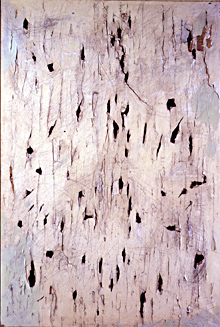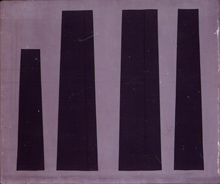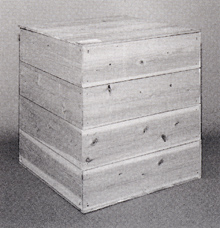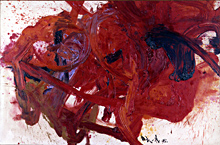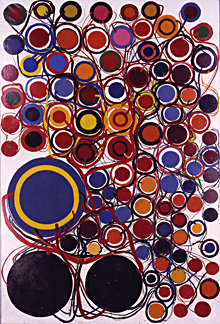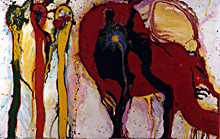2a
具体
Gutai
【本文確定】
美術家と実業家の二つの顔を持ち、美術家としては二科会内部の前衛集団「九室会」のメンバーだった吉原治良の芦屋のアトリエには、第二次大戦終結後ぞくぞくと画家志望の若者が訪れました。「私はその人たちに『今までになかった絵をかけ』と言い渡した。ちょうど20年前にフジタさん(藤田嗣治)から『一切まねはいけないよ』といわれたのと同じように」*2a1。芦屋美術協会や現代美術懇談会の設立に関わった吉原治良は、周囲の美術家たちには「決して人のまねをしない」ことを徹底させました。
こうした空気の中から1954年に設立されたのが「具体美術協会」でした。メンバーは吉原治良を代表として、嶋本昭三、山崎つる子、吉田稔郎、吉原通雄ほか17名。彼らはすでに、野放図でラディカルで、人まねでない作風を実験済みでした。翌1955年1月1日に機関誌『具体』の発刊を果たし*2a2 *2a3、1955年2月には「0会」のメンバー金山明、村上三郎、白髪一雄、田中敦子が「具体」に合流しました。
グループとしての最初のまとまった発表は、芦屋川畔の松林で開催された1955年7月の「真夏の太陽にいどむ野外モダンアート実験展」(芦屋美術協会主催)でした。参加者50名のうち「具体」メンバーは23名。このときグループに加わった元永定正は、赤い水を入れたビニル袋を木に吊しました。
1955年10月には東京の小原会館で第1回具体美術展が開催されました。村上三郎の「紙やぶり」は、ハトロン紙を貼った巨大な木枠を8体並べ、それらを一気に突き抜けるアクション。白髪一雄の「泥にいどむ」は、トラック2台分の泥山にパンツ一丁で飛び込み泥と格闘するアクション。田中敦子の「ベル」は、ボタンを押すと床に設置されたベル群が順番に鳴り響いて遠くまで行き、また帰ってくる作品。
翌1956年4月にはアメリカの『ライフ』誌取材のため「一日だけの野外展」が武庫川畔で行われ、1956年7月には再び芦屋川畔で第2回野外展 (具体野外美術展) が開催されました。嶋本昭三の「大砲絵画」は長さ4mの鉄管に絵の具をつめ、アセチレンガスの爆発で発射、9m×9mのビニルの布に飛沫を飛ばした作品。元永定正の「水」は前年の作品の発展形で、水を溜めたビニルシートが樹間にはりめぐらされたもの。1956年10月の小原会館での第2回具体美術展では、田中敦子が管電球を連ねた「電飾人形-舞台服」を着用しました。
1957年4月、京都市美術館で行われた第3回具体美術展では、金山明がジャン・ティンゲリーより早く「絵を描く機械」(玩具の車に画材を取り付け自走させる)を使用して、「キャンバスに描かれた地上最大の絵」を実演制作しました。1957年5月と7月には大阪と東京の産経ホールで「第1回舞台を使用する具体美術」の開催。しかしこのあとミシェル・タピエが来日し、「具体」の活動内容は大きく変貌しました。これについては後述します。
After the World War II, young aspiring painters came flooding into the atelier of YOSHIHARA Jiro (吉原治良) living in Ashiya as an entrepreneur and an artist simultaneously, who was also a member of the avant-garde group "KYUSHITSU KAI" inside NIKA Association. "I adviced them," told YOSHIHARA Jiro (吉原治良), "'make something never seen before into your painting,' as Mr. FUJITA Tsuguharu (藤田嗣治) told me 'Imitation must not be made at all.' just twenty years ago."*2a1 While taking part in foundation of Ashiya Art Association and GENDAI BIJUTU KONDANKAI (Contemporary Art Discussion Group), YOSHIHARA Jiro (吉原治良) convinced young artists around him to keep "Never imitate others."
It was such atmosphere in which "Gutai Art Association" was founded in 1954 with 17 members such as YOSHIHARA Jiro (吉原治良), the group's representative, SHIMAMOTO Shozo (嶋本昭三), YAMAZAKI Tsuruko (山崎つる子), YOSHIDA Toshiro (吉田稔郎), YOSHIHARA Michio (吉原通雄) and others. These artists had already experimented with their own styles of untamed, radical, and never-imitating-others. They published the journal "Gutai" on January 1st of the following year 1955*2a2 *2a3, and in February 1955 Gutai welcomed the members of "ZERO KAI" (Zero Group), KANAYAMA Akira (金山明), MURAKAMI Saburo (村上三郎), SHIRAGA Kazuo (白髪一雄) and TANAKA Atsuko (田中敦子).
Their fisrt showing as the whole group was in "Experiments of Outdoor Modern Art Challenging the Midsummer Sun Exhibition" (organized by Ashiya Art Association) in a pine forest on the banks of Ashiya River in July 1955. Gutai members made up 23 of the 50 participants of the exhibition, among which MOTONAGA Sadamasa (元永定正), having become a member of Gutai on that occasion, filled a plastic bag with red water and hung them on trees.
In October 1955, the 1st Gutai Art Exhibition was held at Ohara Kaikan hall in Tokyo. MURAKAMI Saburo (村上三郎), in the action "Paper Breaking," pasted kraft papers on eight large wooden frames stood in a row though which he rushed with tearing down papers all at once. In the action "Challenging Mud," SHIRAGA Kazuo (白髪一雄), wearing only a pair of underpants, jumped into and struggled with mud piling up to two truckful amount. In TANAKA Atsuko (田中敦子)'s "Bell," the press of a button made a line of bells on the floor ring in succession from the nearest to the farthest and back again.
In April of the following year 1956, "One-Day Outdoor Exhibition" was held on the banks of Mukogawa River for coverage of Life Magazine in the USA, and in July 1956 the 2nd Outdoor Exhibition (Gutai Outdoor Art Exhibition) was held on the banks of Ashiya River again. SHIMAMOTO Shozo (嶋本昭三) executed "Cannon Painting", splashing paint onto a 9 by 9 meters plastic sheet by exploding paint with acetylene gas inside an iron pile 4 meters long. MOTONAGA Sadamasa (元永定正) developped the previous year's work into "Water," holding water aloft with plastic sheets suspended between trees in the forest. In the 2nd Gutai Art Exhibition at Ohara Kaikan hall in October 1956, TANAKA Atsuko (田中敦子) appeared with wearing "Illuminated Doll - Stage Costume," an outfit woven out of tubular light bulbs.
In the 3rd Gutai Art Exhibition at Kyoto Municipal Museum of Art in April 1957, KANAYAMA Akira (金山明) demonstrated execution of "The Largest Painting on Canvas Ever in the World" with his "A Machine That Paints" (a toy car automated to disperses paint) earlier than Jean Tinguely did. In May and July 1957, "The 1st Gutai Art on Stage" was held at Sankei Kaikan hall in Osaka and Tokyo. However, the direction of activities of Gutai was to change drastically with the arrival of Michel Tapie to Japan, which will be described later.
